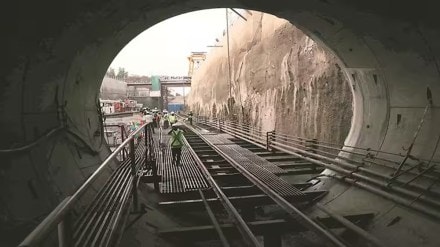In a groundbreaking move to combat the ever-growing traffic congestion in South Mumbai, the city is embarking on its inaugural urban underground road tunnel project, connecting Orange Gate and Marine Drive. This monumental infrastructure development promises to alleviate traffic snarls and usher in seamless connectivity between the city’s eastern and western coasts via key routes like the Eastern Freeway, Mumbai Trans Harbour Sea Link (MTHL), Coastal Road, and the Bandra Worli Sealink.
Two Tunnels, One Vision
Mumbai’s ambitious tunnel project comprises two distinct components. According to an IE report, the first forms part of the existing Eastern Freeway, burrowing through a mountainous terrain. The second tunnel is a vital segment of the upcoming coastal road initiative, delving beneath the sea’s depths. These tunnels, both crafted through greenfield alignments, will play a pivotal role in transforming the city’s traffic landscape. Notably, the Orange Gate to Marine Drive tunnel will weave its way beneath the bustling urban roads, perpetually teeming with traffic, and intriguingly, it will pass beneath Mumbai’s lifeline – its railways, metro lines, utilities, and more.
Easing South Mumbai’s Congestion Woes
The primary aim of this project, as per the IE report, is to alleviate the persistent traffic congestion that plagues South Mumbai, particularly around Orange Gate. This congestion has posed challenges for the Mumbai Port Trust and the Main Post Office square on P D’ Mello Marg, a problem expected to intensify with the impending Mumbai Trans Harbour Sea Link (MTHL) connecting JNPT.
For those unaware, the Mumbai Metropolitan Region Development Authority (MMRDA) is the driving force behind the project’s implementation. Larsen & Toubro (L&T), a renowned name in the construction industry, has been entrusted with the responsibility of bringing this visionary project to life.
Alignment and Tunnel Length
The report suggests that the project’s total alignment spans an impressive 9.5 kilometers, with the construction of twin tunnels covering a distance of 6.5 kilometers. The southbound tunnel, spanning 4.5 kilometers, and the northbound tunnel, stretching for 2 kilometers, will delve to depths of up to 40 meters below the ground. These tunnels will navigate beneath railways, underground metros, existing roads, heritage structures, and other critical infrastructure elements.
Enhanced Connectivity
Upon completion, the project will seamlessly connect to several vital transportation arteries, including the Eastern Freeway, Mumbai Trans Harbour Sea Link (MTHL), Coastal Road, Sewri-Worli Connector, and the Bandra-Worli Sea Link.
Navigating Regulatory Hurdles
The project is not without its share of regulatory requirements, including Coastal Regulation Zone (CRZ) clearance, land acquisition, and traffic management during construction.
Cost and Construction
The estimated cost of this transformative project stands at Rs 7,765 crore, as per the IE report. The construction process will entail the creation of a viaduct for vehicle access at the Eastern Freeway Orange Gate, open cuts, and access roads on both sides of the corridor. The left-side tunnel will pass beneath the seaway and resurface after B D Somani Chowk, before Wankhede Stadium. The alignment incorporates cut-and-cover road sections, viaducts, and tunneling using state-of-the-art Tunnel Boring Machines.
Reduced Travel Time and Emissions
This tunnel promises to significantly reduce travel times between Mumbai‘s eastern and western regions, facilitating seamless access to Marine Drive and the Eastern Freeway. It is expected to slash travel times during peak hours from 30 minutes to just 10 minutes, resulting in reduced carbon emissions and a smoother flow of traffic. Moreover, it will streamline traffic on the Sewri-Worli Connector, MTHL, Eastern Freeway, Bandra Worli Sea Link, and other forthcoming projects connecting Mumbai’s west and east sides, providing quicker access to Navi Mumbai and neighboring areas.
Official Statement
Dr. Sanjay Mukherjee, IAS, Commissioner of MMRDA, told The Indian Express that the significance of these ambitious projects, highlighting their role in enhancing transportation infrastructure and fostering overall development in the region. These projects are strategically planned to complement one another, effectively tackling traffic congestion and offering citizens convenient transportation solutions.
